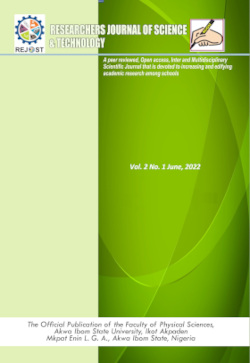Qualitative Screening of Cry1Ac and Cry2Ab Genes in Nigerian Cotton Genotypes Prior to Commercial Release
Keywords:
Bt cotton, Gossypium hirsutum, Cry1Ac, Cry2Ab, ELISA, Nigeria, cotton germplasm, biosafety monitoring, biosafety regulation, transgene introgressionAbstract
A study was conducted during the 2016 dry season at the Institute for Agricultural Research (IAR), Samaru, in the Northern Guinea Savannah of Nigeria to screen fifty-one (51) cotton (Gossypium hirsutum L.) genotypes for the presence of Cry1Ac and Cry2Ab genes. These Bt-derived genes encode insecticidal proteins that provide resistance against bollworms, major pests of cotton. Two qualitative detection methods were employed: Bt lateral flow strips for Cry1Ac and ELISA for Cry2Ab. The genetic materials tested included multi-adversity lines, northern zone lines, eastern zone lines, commercial varieties, and Sabuwa lines. Of the 51 genotypes screened, only two Sabuwa lines tested positive for both Cry1Ac and Cry2Ab, while all others were negative. Limited to qualitative detection, the study nonetheless provides the first baseline evidence of Bt gene presence in Nigerian cotton germplasm prior to the 2018 official approval of Bt cotton. These findings underscore important biosafety and regulatory concerns, highlighting the need for systematic monitoring, enhanced seed certification, and regional harmonization to safeguard varietal integrity and compliance with international biosafety standards.
References
Abdullahi, M., Musa, A., & Garba, U. (2021). Performance and adoption of Bt cotton in Northern Nigeria: Farmers’ perspectives and field observations. Nigerian Journal of Biotechnology, 38(2), 45–55.
Adenle, A. A. (2014). Stakeholders’ perceptions of genetically modified crops and biosafety regulations in Africa. Food Policy, 45, 38–49. https://doi.org/-10.1016/j.foodpol.2013.12.009.
Adeoti, S. O., Ajayi, A. M., & Agunbiade, M. O. (2020). Yield estimation and profitability of cotton production in Northern Nigeria., 8(10), 215–220. https://doi.org/10.33495/jacr_v8i10.20.188.
Akanbi, T. A., Olukosi, J. O., & Ayinde, J. O. (2018). Economic analysis of cotton production in Nigeria. Journal of Agricultural Extension and Rural Development, 10(7), 146-153. https://-doi.org/10.5897/JAERD2018.0996.
Alliance for Science. (2018, July 19). Nigeria commercializes Bt cotton, its first GMO crop. Alliance for Science. https:// Journal of Agricultural and Crop Research allianceforscience.org/blog/2-018/07/nigeria-commercializes-bt-cotton-first-gmo-crop/.
Bajaj, S., Singh, R., Ali, S., & Koundal, K. R. (2023). Assessment of Cry1Ac and Cry2Ab proteins in pollen of various transgenic cotton cultivars and effect on Apis mellifera L. colonies’ development. Environmental Science and Pollution Research, 30(7), 18765–18774. https://-doi.org/10.1007/s11356-022-24395-4.
Celia, V. C., & Khetarpal, R. K. (2006). ELISA-based detection of GMOs. Division of Plant Quarantine, National Bureau of Plant Genetic Resources, New Delhi.
Chen, D. H., Ye, G. Y., Hu, C., & Peng, Y. F. (2005). Evaluation of the effects of Cry1Ac-expressing cotton on the non-target pest Helicoverpa armigera (Hübner). Environmental Entomology, 34(5), 1257–1262. https://doi.org/10.-1603/0046-225X-34.5.1257.
CICR. (2012). Bt Express Kit instruction manual. Central Institute for Cotton Research, Nagpur, India.
Daily Trust. (2023, April 10). Despite N10trn annual interception, smuggling thrives. Daily Trust. https://dailytrust.com/-despite-n10trn-annual-interception-smuggling-thrives/
Hayrapetyan, H., Tran, T., Tellez-Corrales, E., & Madiraju, C. (2023). Enzyme-linked immunosorbent assay: Types and applications. Methods in Molecular Biology (Vol. 2612, pp. 1–17). Springer. https://doi.org/10.1007/978-1-0716-2903-1_1.
Jans, Y., von Bloh, W., Schaphoff, S., & Müller, C. (2021). Global cotton production under climate change – Implications for yield and water consumption. Hydrology and Earth System Sciences, 25(4), 2027–2041. https://doi.org/10.5194/hess-25-2027-2021.
Karcher, S. J. (2002). Blue plants: Transgenic plants with the GUS reporter gene. Department of Biological Sciences, Purdue University.
Khan, N. U., Hassan, G., Kumbhar, M. B., Parveen, A., & Ahmad, W. (2014). Agronomic management strategies for higher cotton production. Pakistani Journal of Botany, 46(1), 9–20.
Komen, J., & Koch, M. (2007). Biosafety policy and practice: Advocacy and capacity building for biosafety in Africa. ISNAR/IFPRI.
Lequin, R. M. (2005). Enzyme immunoassay (EIA)/enzyme-linked immunosorbent assay (ELISA). Clinical Chemistry, 51(12), 2415–2418. https://doi.org/-10.1373/clinchem.2005.051532.
Liao, C., Jin, M., Cheng, Y., Yang, Y., Soberón, M., Bravo, A., Liu, K., & Xiao, Y. (2022). Bacillus thuringiensis Cry1Ac protoxin and activated toxin exert differential toxicity due to synergistic interplay of cadherin with ABCC transporters in the cotton bollworm. Applied and Environmental
Microbiology, 88(7), e02505-21. https://doi.org/10.1128/aem.02505-21.
Manickam, S., Gururajan, K. N., & Gopalakrishnan, N. (2013). Bt cotton vis-à-vis environmental protection: An Indian perspective. TNAU Agritech Portal.
Muzaffar, A., Kiani, S., & Khan, M. A. U. (2015). Chloroplast localization of Cry1Ac and Cry2A protein: An alternative way of insect control in cotton. Biological Research, 48(14), 1–12. https://doi.org/10.1186/s40659-015-0005-2.
National Biosafety Management Agency. (2018). Permit for the commercial release of genetically modified cotton. National Biosafety Management Agency, Nigeria.
OFAB. (2012). The potentials of Bt cotton in revamping the textile industry. Open Forum on Agricultural Biotechnology, March edition.
Quist, D., & Chapela, I. H. (2001). Transgenic DNA introgressed into traditional maize landraces in Oaxaca, Mexico. Nature, 414(6863), 541–543. https://doi.org/-10.1038/35107068.
Rajamohan, F., Lee, M. K., & Dean, D. H. (1998). Bacillus thuringiensis insecticidal proteins: Molecular mode of action. Progress in Nucleic Acid Research and Molecular Biology, 60, 1–27. https://doi.org/10.1016/S00796603-(08)60887-9.
Ramaswami, B., Pray, C., & Lalitha, N. (2012). The spread of illegal transgenic cotton varieties in India: Biosafety, economic, and policy implications. World Development, 40(1), 56–69. https://-doi.org/10.1016/j.worlddev.2011.05.028.
Ramaswami, B., Pray, C., & Lalitha, N. (2012). The spread of illegal transgenic cotton varieties in India: Biosafety, economic, and policy implications. World Development, 40(1), 56–69. https://-doi.org/10.1016/j.worlddev.2011.05.028.
Sanou, J., Zida, E., & Traoré, O. (2019). Biosafety, fiber quality, and socio-economic impacts of Bt cotton in Burkina Faso: Lessons learned for West Africa. African Journal of Agricultural Research, 14(10), 421–430. https://-doi.org/10.5897/AJAR2018.13700.
TNAU Agritech Portal. (2023). Bt cotton: Cry genes and insecticidal activity. Available at: http://www.agritech.tnau.ac.in (accessed March 15, 2023).
Voora, V., Larrea, C., & Bermudez, S. (2020). Global Market Report: Cotton. International Institute for Sustainable Development (IISD), Winnipeg, Canada. https://www.iisd.org/system-/files/2020-10/ssi-global-market-report-cotton.pdf.
Wan, P., Zhang, Y., Wu, K., & Guo, Y. (2002). Seasonal expression profile of Cry1Ac protein in Bt cotton and its effect on the control efficiency for cotton bollworm. Journal of Economic Entomology, 95(4), 832–837. https://doi.org/10.1603/0022-0493-95.4.832.
Yahaya, A. I. (2017). Genetics of resistance to leaf roller (Sylepta derogata) and agronomic characters in intra- and inter-specific cotton crosses (Ph.D. thesis). Ahmadu Bello University, Zaria, Nigeria.

Downloads
Published
How to Cite
Issue
Section
License
Copyright (c) 2025 Researchers Journal of Science and Technology

This work is licensed under a Creative Commons Attribution-NonCommercial-NoDerivatives 4.0 International License.




